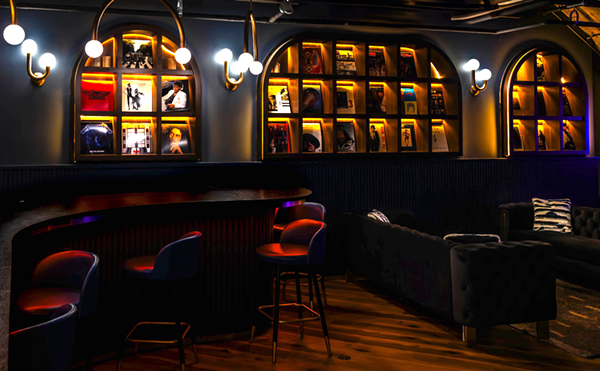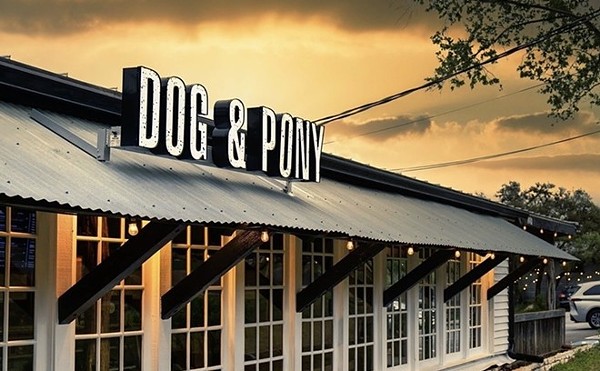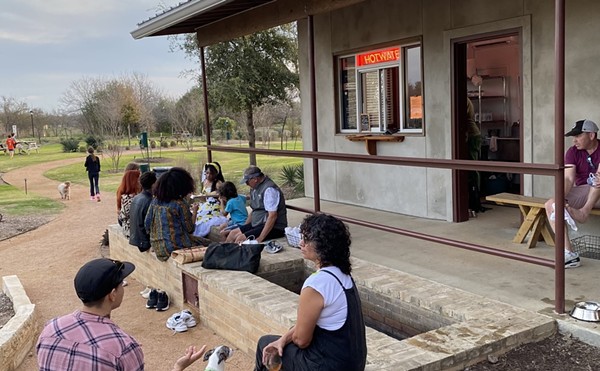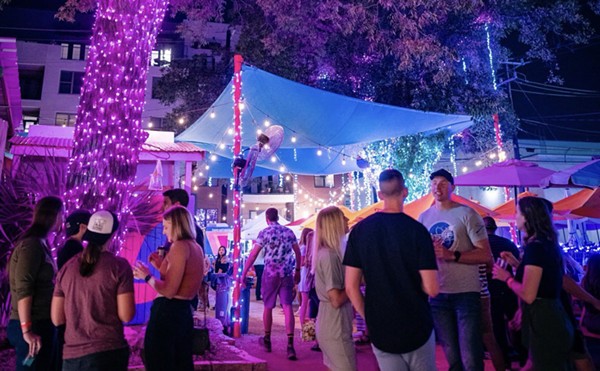During the past nine years, James Beard award winning food writer Josh Ozersky has curated a carnivorous carnival in New York City known as Meatopia. The event brings talented chefs from across the country together with one goal in mind: celebrating all kinds of meat, prepared in a plethora of ways.
In 2013, Meatopia and Ozersky branched across the pond for London’s inaugural event in early September and now the time has finally come for San Antonio to play host..
Meatopia TX, held November 2 and 3 at the Pearl, will host 32 of the country’s most celebrated chefs including Austin’s Paul Qui (winner of Top Chef: Texas) along with Dallas’s Tim Byres of Smoke and Chris Shepherd, of Houston’s Underbelly."
To get a better sense for the event, we’ve chatted with idea-man Ozersky on why SA beat out other Texas cities; The Granary’s Tim Rattray who Ozersky named the future of barbecue on his trajectory from cook to owner; and Chris Hughes, owner of Broken Arrow Ranch (which is supplying antelope and venison for the event) to get an inside look at how game makes it to local menus.
The Writer
Josh Ozersky
When did the meat love affair begin?
Ozersky: I was a solitary and unhappy child who found in meat the only solace and companion that made life bearable for me. Meat was not just my imaginary friend, it eventually morphed into girlfriend in my 20s and wife in my 30s.
I can’t tell if you’re joking…
Neither can I.
What did you find so appealing about it?
Ozersky: There’s something visually satisfying about meat, you know how they’d say that lonely women would eat chocolate? Well, lonely children named Josh Ozersky would eat meat because it mimicked the feeling of being happy. Essentially I self-medicated with meat and in the process learned about it. It served me well as literary fodder and as a mood elevator.
What was the catalyst for bringing Meatopia to SA?
Ozersky: There were really two catalysts, both necessary and powerful. I would never have been truly fulfilled without doing an event in Texas. It’s a beef state. We were shopping different places to do it and as you might imagine someone from out of town that doesn’t know much about Texas, my thoughts went to Dallas, Austin. I had the good fortune to be invited to a tamale festival at the Pearl and was so struck. It’s a beautiful place, vigorous, it was the perfect partner for the Texas event I had long dreamed of. I had expected to go there and eat Tex-Mex food, instead I had what I still think is the only modernist barbecue (from The Granary), and seafood (from Sandbar) in San Antonio, which was the last thing I expected to find. I was introduced to exotic food produced at Nao that I had never been exposed to. There’s a depth of diversity and power to the restaurants of the Pearl. I was of the mentality that the only good food in Texas was in Austin…
Would you say that’s turned you into an advocate for the city?
Ozersky: I’ve become a de facto champion of the city within the food media community in New York, which don’t think of San Antonio except in terms of the Alamo. They might ask, “What’s the Riverwalk or there’s a SeaWorld in San Antonio?” I got to see the beautiful parts as I became friends with Elizabeth Fauerso of the Pearl and I came to appreciate it. For a food writer to discover a great city, was a great coup for me.
What part did Tim Rattray play in your decision?
Ozersky: I think Tim opened my eyes to how special the place was. Nao was obviously something I’ve never experienced…I had been to steakhouses, seafood places, but The Granary opened my eyes to find a restaurant that was so original and I felt it was significant on a national level. He’s not the only one in town that’s a great chef, but to my knowledge (he’s) the only modernist chef. His work wouldn’t have happened in a place like Austin with such a strong barbecue tradition. Tim showed me there was an opportunity to do things in San Antonio that are new. Texas is very culturally conservative, they like to do events with strong Texas roots, and powerful, regional traditions. If Tim could do something that original at Pearl, I could too.
What dish set him apart for you?
Ozersky: The cauliflower. His beef clod is incredible, the pastrami beef rib is amazing, but his specialties blew me away. The fact that someone could do a vegetable dish that I could be impressed by made me rethink how I thought of barbecue. The Granary has absolutely A+++ ribs and pulled pork…the fact that he could make standard barbecue comparable to Kreutz or Aaron Franklin, or some great restaurants in the deep south, really woke me up in a way that might not have been otherwise.
What should people know about the event before heading there?
Ozersky: The best part of Meatopia is that it’s a true culinary event, the only one I know of organized by a food person as opposed to a marketing event.
How did you settle on the chefs?
Ozersky: I decided most had to be Texas chefs. You don’t have to come to Meatopia to have great barbecue, this isn’t just barbecue. Meatopia shows people things they’ve never eaten, parts of the animal or ethnic traditions.
What dish are you most looking forward to?
Ozersky: I won’t pick a favorite, but Andrew Weissman has something lined up that’s so complicated and ambitions and original, that’s something that’s so in my wheelhouse. I’m excited to have Jesse Griffiths (of Dai Due in Austin) braise doves.
Any last need-to-knows?
I know that Meatopia is something that a lot of people have never been to or have a frame of reference for, but I would really, really urge…even it if costs more than food events, you’ll eat so many different things you’ve never had before. It’s a special experience. I urge them to take a chance I’m taking on them and give Meatopia a shot. It’s an all you can eat, best meat in the world, cooked by a dream team of chefs (event). If you consider yourself a serious carnivore, it would be worth it.
The Chef
Tim Rattray, The Granary
Let’s run through your work history a second…
Rattray: My first job was at Biga on the Banks. I was there for almost a year. I heard about what Andrew Weissman was doing at Le Reve and I wanted to be a part of it. I talked to Bruce and told him I thought it was time for me to get into something different. He was really supportive…actually, he might have called Andrew for me. Andrew wasn’t hiring at the time, but I met with him, poured my heart out and trailed him for the night. He let me taste stuff as they were cooking. Andrew ended up making a spot for me. I spend the next few year with him and worked my way up. It was the best spot, the Le Reve kitchen was such a small kitchen, you had to learn a little bit of everything. I met really good cooks that I’m still friendly with and talk to. Later, I helped open Il Sogno and later Sandbar as opening sous under chef Chris Carlson. I decided to take some time and stage in New York with people I’d contacted on twitter and via blogs. I did Le Cirque for a while and staged with Le Bernandin.
What was that experience like?
Rattray: I’d grown up on a big city but had never been in a place like New York. I had a chance to eat …it was an eye opener. When I came back I started thinking that at some point I would love to do something on my own based on the ideas that I had.
Did you think The Granary would ever turn into such a hit?
Rattray: No. I laugh about it with my brother. Even if we were in the best spot, we were just two guys no one knew about, we were doing weird stuff. It was a tough sell for people as a whole especially with the evening. We thought, ‘Hopefully in a few years, we’ll build a clientele,’ and in the first few months, this blew up. We were so busy doing 18 hour days, seven days a week. We just had to keep our heads down and keep going so we wouldn't drown. It’s been great. I’m appreciative, but I can’t rest on that. I have to keep trying to get better every day. I used to say a goal without a timeline is just a dream. At 26, I used to say if I can have a restaurant by the time I’m 30, I’ll be good. Now, I’m 30 and I feel like I’m behind. (He laughs).
What part did you play with Josh’s first visit?
Rattray: The Pearl people told me they were trying to court him. I’m pretty active on following people in New York, San Francisco, so I knew about Meatopia. It was more of trying to put our best food forward. Make delicious food, great beer and show them what we’re doing. He ended up just loving it. Josh is a polarizing figure so some people, but I really loved and appreciated when he told me what he liked and what he didn’t.
What do you think the event will do for the city?
Rattray: I think for everyone that’s cooking and making awesome beverages and cocktails, it’s great that (the event) is coming down here. It’s a personal opportunity to show people what we’re doing. It’s a time to step up our game and put out good, quality food so these chefs think of San Antonio as a place to go back to.
What’s your favorite cut of meat to work with?
(He pauses.) I don’t even know if I can answer that. There’s something about perfectly smoked chicken, and melt-in-your-mouth brisket. It’s almost like picking your favorite child. I can’t even choose a favorite animal. You can’t really substitute aged steak from a cow. I like it all. The thing I enjoy most about The Granary is that if we want to experiment, we can order it in. If we want smoked rabbits, we’ll order some rabbits. I’m increasingly growing to love manipulating vegetables. It’s an underappreciated food group. The result is something really unique and I think delicious. We play with textures a lot, crunchy, soft, hot, cold.
The Producer
Chris Hughes, Broken Arrow Ranch
How does Broken Arrow work?
Hughes: We don’t actually own or raise any animals. What we do is work with ranches around the state with overpopulation of non-native deer and antelope. These are wild animals on large acres. What we do is take a shooter, a skinner on our mobile processing facility and choose a central location on the ranch where we basically hunt. We harvest with a single shot to the head at a distance of about 200 yards from the animal. We electro-stimulate it, which helps bleed it and contract the muscles (the benefit of which help remove the gamey flavor), take it back to the mobile processing unit where it’s skinned and eviscerated and in a cooler within an hour. We weigh the animal, and pay the rancher based on weight of the animals harvested. It’s a win-win-win. The ranchers get population reduced and they get paid for it, the animals live a natural wild life without stress, and we win as producers.
How often do you go to these ranches?
Hughes: We operate on an as-needed basis for each ranch. We have a database that fluctuates where we keep in contact with over 100 different ranchers and we harvest off 25-35 ranchers a year.
Where do you find shooters?
Hughes: We have two full-time shooters on staff. That’s their job. They also help to organize hunts and keep the harvest. It takes a lot of practice and training to do it well.
How did you get into the business?
Hughes: I’m second-generation. My father started it in 1983. I came back in 2005 and took over running the company, but I was doing all sorts of things. I graduated with an engineering degree, went into advertising in Houston, then worked overseas for Haliburton in Bosnia and Macedonia. I came back and got my MBA at Wake Forest and then I decided to become a butcher. (He laughs).
What are some of the challenges you face?
Hughes: Supply. We market ourselves to the ranches, letting them know we are a resource and establishing a connection. It takes a lot of trust for us to come on and do these harvests. The method is self-limiting; we can do up to 40 animals in one evening. Sometimes we average 15 or 20, sometimes we’ll hunt all night and come back with zero. It also has to be a large enough area of land or else they’re not really free-range. We don’t want to stress the animals. We’re working on minimizing or eliminating stress at the time or harvest, which helps the quality of the meat.
What do home-cooks have to know about game?
Hughes: There’s an old saying, “there are two ways to cook game, a little or a lot.” What that means is on the tender cuts, steak tenderloins or leg filets that are very lean, you don’t want to trim anything off or cook past medium rare over a hot fire. On the flipside, because these are wild animals, they develop a lot of connective tissue in their shoulders and flanks. You want to cook that slowly over low heat for a long period of time to break down the tissues. It’s an absolute flavor bomb.

















